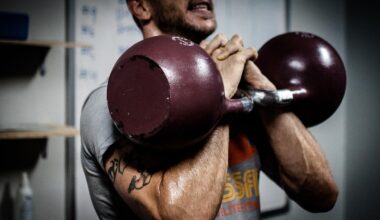Case Studies: Success Stories in VO2 Max Improvement
VO2 max is a critical measure of athletic performance and endurance. Numerous athletes have dedicated themselves to improving this crucial component. This involves extensive training, personalized programs, and unwavering commitment. For example, one notable case study showcases a professional cyclist who improved his VO2 max significantly. Through a combination of interval training and endurance rides, he recorded an increase of nearly eight percent in just three months. The cyclist utilized high-altitude training, which enhanced oxygen uptake and improved overall performance. Athletes participating in rigorous training can experience similar outcomes when they focus on tailored regimens that align with their specific needs. A vital component is also nutrition; the right fuel can make a significant difference. The individual’s training plan must incorporate a strategic balance of workouts and recovery periods. Personal coaching and regular assessments also contribute to sustained development. Various professionals in the field emphasize that monitoring progress keeps athletes motivated. Effective use of technology for tracking improvements can assist in setting achievable goals based on initial VO2 max levels. Continuous adaptation of workout plans ensures growth and bolsters consistency in training. Understanding these cases can provide inspiration and proper strategies for enthusiasts.
A second case involves a recreational runner who sought to increase her VO2 max for upcoming races. She focused on implementing a structured training plan that incorporated long runs, tempo workouts, and interval sessions. With diligent training over a span of four months, her VO2 max improved markedly. To achieve desired results, she made dietary adjustments alongside her workout routines. Supplementing with antioxidants and maintaining hydration were key strategies employed. The runner also prioritized her sleep and recovery to maximize her training efficiency. Incorporating strength training into her regimen helped boost her running efficiency. She sought professional coaching support, which provided personalized advice. Monitoring her progress became essential, allowing her to adjust training as needed. Her success story illustrates how commitment can lead to remarkable progress. Regular testing of VO2 max through controlled lab and field tests showcased her improvements. Adding variety to her training kept her engaged and motivated. Sharing her journey on social media platforms inspired fellow runners to pursue similar goals. This sense of community instilled enthusiasm. Continued dedication and a passion for progress are paramount for anyone looking to enhance their athletic capabilities. Inspired, many runners started on their personal challenges.
Another Success Story: A Triathlete’s Journey
A talented triathlete sought to enhance her VO2 max for an upcoming competition. Committing to an intensive training program allowed her to experience substantial improvements. She integrated high-intensity interval training (HIIT) into her schedule and transitioned from basic aerobic exercises to more demanding routines. This drastic change in training methods led to a recorded increase of over ten percent in her VO2 max within a few months. The incorporation of swimming and cycling into her weekly routines maintained her cardiovascular training while also enhancing muscle endurance. Regular testing allowed her to monitor performance changes, which played a significant role in shaping her training plan. Resistance training became a vital part of her regimen, strengthening her core and improving overall efficiency. Nutritional adjustments were equally crucial as she focused on providing her body with adequate energy levels before rigorous training sessions. Hiring a sports nutritionist aided her in optimizing her diet. Peer support also acted as motivation, with training sessions shared among friends. The athlete’s determination and strategic focus empowered her success. By achieving significant VO2 max enhancements, she reignited her competitive ambitions and encouraged other triathletes to pursue their goals.
This success story features a soccer player striving to enhance his endurance and on-field performance. Maintenance of superior VO2 max is often pivotal in competitive environments. Through a rigorous training regiment that included both aerobic and anaerobic workouts, he diligently focused on improving his aerobic capacity. With the aid of a sports scientist, he developed specific drills designed to push his limits. Over five months, this soccer player exhibited a significant improvement, raising his VO2 max by an impressive six percent. Emphasizing the importance of tactical drills alongside endurance sessions made his training holistic. Incorporating plyometric exercises added an interesting dimension to his workout, enhancing agility and speed. Regular assessments on the field allowed him to benchmark his performance, leading to informed adjustments. He embraced nutrition as an essential element, ensuring optimal fuel usage on game day. Strategic hydration during training sessions aided recovery and overall performance. Peer collaboration added engagement, enhancing the often strenuous process of training. Observing the improvements affirmed the necessity of structured practices with clear goals. His journey reveals how systematic efforts and focus on several training aspects can lead to noticeable performance elevation in competitive environments.
Pushing Boundaries: A Mountain Runner’s Experience
One mountain runner’s objective was to dramatically boost her VO2 max to compete in high-altitude events. These races necessitate exceptional aerobic capacity, particularly for climbing and downhill sections. She engaged in monstrous elevation gain sessions during her training. Embracing steep terrain, she aimed to improve both strength and VO2 max through strategic hill sprints and longer runs. With persistent effort, her VO2 max increased by nearly fourteen percent over four months. The terrain challenges proved integral in enhancing her cardiovascular efficiency. Additionally, she integrated altitude training protocols to adapt her body to lower oxygen levels. Monitoring her VO2 max regularly provided insights into her progress. Nutrition played a pivotal role as she ensured adequate calorie intake from diverse food sources. The mountain runner recognized that rest and recovery were equally important for sustained progress. Gradually, her confidence grew as benchmarks indicated the fruits of her labor. Engaging with the mountain running community offered shared experiences and encouragement. This journey exemplified the effort and method required in a competitive arena. Ultimately, her success became a testimony to dedication and strategic preparation in pursuit of her VO2 max goals.
Another compelling scenario emerged with a masters-level athlete who was inspired by the potential of improving his VO2 max. At 45 years old, he recognized that sustained athletic performance demanded focus. Implementing personalized workout strategies allowed him to realize significant gains. His approach combined progressive overload in training sessions while emphasizing recovery and nutrition. Testing indicated a substantial enhancement in VO2 max by eight percent, showcasing that age need not be a barrier to improvement. Targeted workouts that included varied intensity and duration contributed to enhancing aerobic capacity. Incorporating regular feedback on his progress inspired further refinements. He partnered with a local trainer to keep motivation high and develop a structured plan. Developing a community with like-minded individuals helped bolster his commitment to set goals. Nutritional choices focused on lean proteins and whole foods, promoting optimal recovery. Adjustments in hydration and supplementation further facilitated performance. Feedback rounds and consistent assessments aligned with adjusting protocols to reflect progress. This journey showed that holistic strategies yield results regardless of age. It affirms that every athlete can achieve their potential through diligence and strategic planning to improve VO2 max effectively.
Conclusion: The Path Forward in VO2 Max Improvement
The stories above exemplify that improving one’s VO2 max is a realistic goal achievable through targeted effort. Athletes of all backgrounds have succeeded by effectively combining training, nutrition, and recovery. They highlight that tailored training plans accommodating individual needs yield better results. The application of technology to measure progress ensures objectives stay aligned with training efforts. Engaging in community with fellow athletes promotes shared experiences, thus providing additional motivation. Consistently assessing one’s performance sets the groundwork for necessary adjustments over time. Moreover, nutrition and recovery, often overlooked, play vital roles in a successful training regimen. Establishing a holistic vision fosters long-term engagement with athletic pursuits. Adapting training to both current fitness levels and desired outcomes ensures that improvement is continual. As these case studies reveal, determination and strategic planning unlock potential while overcoming obstacles. With a clear focus, elevating VO2 max becomes achievable. Athletes should remember to stay patient and persistent in their endeavors. No matter the background, opportunities abound for improvement, pushing boundaries forward in the realm of fitness.
Additionally, understanding individual physiological differences can guide athletes in selecting the best training methods suited for them. Emphasizing the importance of personalized approaches ensures efforts yield the intended outcomes. Many athletes have demonstrated that, by fervently pursuing strategies outlined in these case studies, significant performance enhancements can be attained. As research continues to evolve, athletes will have access to improved methodologies for realizing their full potential.


